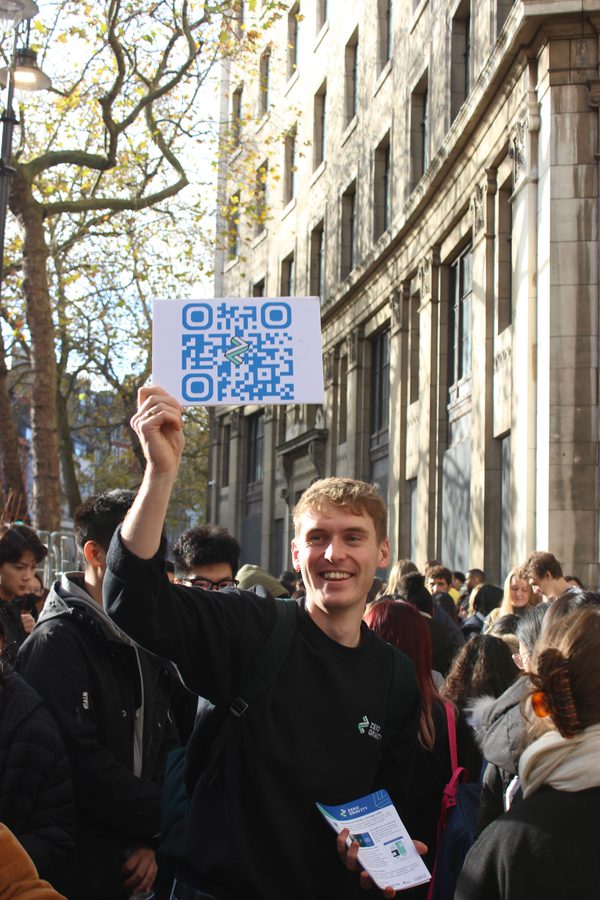
Closing The Gap: How to hire socially mobile talent

By Zero Gravity – 24th October 2023
This article was written by Zero Gravity for IHR, and was originally housed on their website
Every year, 50,000 students from socially mobile backgrounds achieve top GCSE’s. Yet only a third of these students make it to a highly-selective university, and even fewer enter a top graduate career.
Statistics like these are almost embarrassingly commonplace, and we’ve become desensitised to their format: an impressive figure demonstrating the vast existence of high-talent, low-opportunity students, immediately followed by a qualification that this talent is almost always squandered. The fact is, every statistic about social mobility details the same hard truth. Talent is spread evenly, but opportunity is not.
But poor representation of socially-mobile talent at elite universities and careers has nothing to do with an absence of talent in low-opportunity students. Factors such as the Network Advantage, resource droughts and imposter syndrome keep talent back from the education and careers that they truly deserve to be in.
Network Advantage
In 2022, Zero Gravity conducted UK wide research on the benefits of the ‘Network Advantage’ (laterally coining the term post-research), which refers to the intangible advantage obtained through access to a broad professional network.
This network is made up of individuals who have attended high-tariff universities and/or worked in high-level professional jobs, and are able to offer young people specialised interview and application help. From parents to teachers, the network serves to provide the crucial insider knowledge to push an applicant through the door. “It’s not what you know - it’s who you know” encapsulates the phenomenon, as young people can leverage a network of teachers, carers and family friends to multiply their success.
But for aspirational working class students who haven’t been born into a circle of university-educated professionals (i.e. if a student is pursuing a specialised academic career but have parents that operate in trade/domestic circles), they are at a distinct disadvantage. Without an obvious individual to ask to redraft their personal statement or how to conduct themselves in an industry-specific interview, their chances of succeeding are significantly impeded before their intellect or capability enters the equation. Particularly for interview processes infamous for being shrouded in mystery such as the Oxbridge interviews, the findings from the Zero Gravity Gap Zero Report [published 2022] showed that the average private-school student will know 9 people to ask for help from, compared to a state-educated student who is as likely to know 0.
This issue prevails beyond academics into the career and degree apprenticeships sector, as a state-educated student is 4x less likely to know a lawyer, 2x less likely to know an accountant and 7x less likely to know a banker. As such they are at a significant disadvantage to break into the careers sector, both as a graduate or when applying for degree apprenticeships, a popular new option which was once the reserve of the state-educated but is now being pushed by private schools.
Recent studies show that now only 5% of companies are taking on students from lower income households [Dr Eliza Filby, CityAM, 2023], as a result of a network of “parents indulging in cringey professional networking and LinkedIn-stalking on behalf of their children” [Filby, 2023]. And none of this is based on talent - simply a lottery of whether you inherit this great network by virtue of birth or not.
Awareness Gap, Accessibility Gap and Resource Drought
To put it simply - low-opportunity students simply don’t know which opportunities are out there for them. These students often exist in conversion ‘cold spots’ in the UK, held back by geographic, socioeconomic and educational boundaries, leading to an awareness gap of the opportunities out there.
Students who manage to evade the 'awareness gap' are then often foxed by an accessibility gap, as a student in a rural area will require additional means to attend an open day or an interview, such as funding to travel for an interview: something which is not always financially viable for those from a low-opportunity background. Even the most motivated employer cannot hire the most talented student if - simply - they cannot get to one another. Low-opportunity students who manage to evade these two phenomenons (eg. those who live in urban areas) will often finally be defeated by the resource drought.
A resource drought refers to the complete lack of specialised resources required to achieve success. Such resources are crucial for any student - regardless of background - approaching academic, internship or career applications. This can include: the soft skills of how to dress, act, and answer a question, alongside application presentations, practice entrance exams and mock interviews with teachers. This upskilling can be carried out from parents working professional jobs, to Oxbridge-educated teachers.
Private schools are particularly adept at utilising alumni to support their students with university applications and hiring education consultants who have previously worked with the families of current and former students. This dynamic leads the Network Advantage to influence the quantity of individual-level support offered by schools, which then influences students’ chances within the university admissions process.
But for students from working class backgrounds - who were more than twice as likely to report having received 0 hours of support from their school compared to middle class pupils [Gap Zero, 2022] - they aren’t aware of these soft-skills which will give them the necessary edge in interviews. They cannot access the level of professional finesse acquired by their middle - and upper-class counterparts. Regardless of intellectual capability, they appear less ‘polished’ than their fellow students. One could argue that many of these questions could be answered by a quick Google search - but if a student doesn’t know what they’re missing, how will they know that they need to look?
Imposter Syndrome
Years of class inequality in academic and careers spaces due to the outlined reasons has created its own problem: imposter syndrome. When low-opportunity students don’t see their backgrounds reflected in their desired sectors, they are made to question if ‘people like them’ belong in those industries. For a range of socioeconomic factors from self-consciousness over having a ‘working class accent’ or a lack of cultural capital possessed by their peers, 33% of state educated students were worried about feeling out of place at a Russell Group uni compared to 0% of private school students [Gap Zero, 2022].
Students simply don’t see themselves represented in the industries that they desire to go into, from business, where 75% of founders come from socio-economically advantaged backgrounds [Sifted, 2021], to the arts, as 43% of the UK’s 100 most influential editors and broadcasters are privately educated [Sutton Trust, 2019].
Industries such as law were particularly affected, with 22% of lawyers attending a fee-paying school compared to 7.5% of the general population, and only 17% of lawyers coming from a lower socio-economic background compared to 39% of the general population [SRA data].
Even STEM industries were affected - engineers from more advantaged socioeconomic backgrounds were “almost 4 times more likely to work in an intermediate, managerial or professional role by age 30 to 39 than those from a lower socio-economic background, with differences between these groups being apparent even after accounting for the effects of their highest qualification” [Engineering UK, 2022].
A lack of socioeconomic diversity in industry then creates a vicious cycle in which socially-mobile talent self-disqualifies, omitting themselves from the application pool - and so the cycle continues.
Why does this matter?
The lack of socially-mobile talent in academic and professional spaces presents an obvious moral imperative to create a more equitable system for talent to thrive in the UK. It is evidently time for change, as social mobility has been stagnant for a generation - according to the OECD, it would take the offspring of low income families five generations to reach average income levels [OECD, 2021].
But it’s not just a social issue - it’s bad for business. Top employers are losing out on diverse talent and innovative thinking. They’re not just leaving talent on the table, they’re compromising their brand, limiting their appeal to a diverse workforce, and stunting their own growth and the growth of an economy. If we increase social mobility in the UK to the Western average, GDP could be £39bn higher by 2050 [Jenkins et al, 2022].
For the motivated employer seeking to fix this issue, a range of difficulties await them: an employer’s inability to contextualise talent and pinpoint true social mobility factors in the talent landscape, industry misconceptions and ensuing imposter syndrome held by socially-mobile students, an employer’s reliance on the traditional ‘milkround’ approach which focuses on a handful of prestigious institutions who themselves can struggle to recruit socially-mobile students, and socioeconomic and geographic barriers between talent and employers - leading to high time and financial costs for companies to surpass.
1. Starting Small
Before starting the active hiring process of socially-mobile talent, employers need to make sure that their current process isn’t accidentally screening out socially-mobile applicants.
Designing an inclusive recruitment strategy can assist with this - training recruiters and hiring managers to be aware of unconscious biases, promoting diverse job ads and outreach, and ensuring that entry requirements (like certain degrees or experiences) don't unfairly exclude those from lower socioeconomic backgrounds. Consider implementing blind recruitment practices to avoid unconscious biases from affecting hiring decisions.
Another key step before beginning active hiring is to get buy-in from the wider team by explaining the crucial ‘why’ of your mission to hire socially-mobile talent. Buy-in from the Executive Team is an essential first step, particularly if you can secure an Exec Sponsor to assist with the process.
Then, leverage your employee network groups, bringing together focus groups of those that share characteristics to provide them a platform to express perspectives, concerns etc. This boosts a sense of belonging and purpose to existing employees as well as prospective candidates.
2. Actively Identifying socially mobile talent
The first task for active employers seeking to hire socially-mobile talent? How to identify it.
Pinpointing true social mobility indicators in the talent landscape can be measured through a series of proxies eg. a candidate should display measurable talent (i.e. excellent school and university grades), or display natural potential. Measuring for ‘potential’ is not as ephemeral as it appears - examining how a student has consistently outperformed their projected success within the context of their school, area, or background can act as a solid proxy.
With regards to social-mobility, many individuals will not self-identify as ‘working class’ or ‘low opportunity’, meaning that employers must rely on data to calculate a deprivation index. This can include a range of open-source government data, such as street level income, progression rates from the student’s area and other traditional widening participation criteria (eg. areas where participation in higher education is low, or first-generation students).
A key factor to screen for is to ensure that a candidate is state-educated. Whilst many talented students from deprived areas often win scholarships to private schools, these students have often fostered a network advantage and are considerably more socially mobile than their peers, meaning that a state-educated pupil - particularly those from state comprehensives - are where employers should focus their attention.
Zero Gravity is aware of the complexities of identifying socially-mobile talent for time-strapped employers: measuring application, drive, WP factors, performance outside their background, etc. Zero Gravity sought to build a ‘talent algorithm’, which indexes against our digital database to derive an axis point between top talent indicators and social mobility indicators. Using algorithmic identification to find the top 15% of performing talent from the bottom 40% of social advantage, Zero Gravity plugs directly into over 20% of UK state schools to meet the UK’s leading socially mobile talent right at the start of their journey.
For employers, access to such a network ensures two key factors: talent and potential for social mobility. Leveraging existing databases allows employers to bypass the resource-intensive identification stage, and instead directly access a pre-qualified pool of talented socially-mobile students.
3. Create a network between your company and socially-mobile talent
Critically, employers should make sure that they have a presence in socially-mobile spaces.
Due to the awareness and accessibility gap faced by low-opportunity students, many are simply unaware of which opportunities are out there for them. As a result, employers must go directly to where the students are to create connections, such as societies, clubs, school groups and university groups.
However, issues with the ‘milkround’ recruitment technique can see employers concentrated around one or two schools near their offices - leading to a high effort, limited, and concentrated impact which excludes those from rural or coastal areas in the UK.
To reduce time, slash costs, and increase impact, employers must scale their impact through engaging with technology. This can be achieved through entering digital spaces where talent pools of socially-mobile students exist.
For example, when HSBC made an organisation commitment to recruiting socially mobile talent for their Headstart programme, they entered into a partnership with Zero Gravity. This enabled them access to the digital community of exclusively socially-mobile talent, allowing them to showcase their business to candidates. Furthermore, their partnership (exemplified by existing in a socially mobile space) distinctly showcased to the members that this was a company that was seeking socially-mobile talent, which will begin to remove the temptation of socially mobile talent to self-disqualify.
Partnering with social mobility organisations then enables employers to target specific candidates through mentoring. When pairing a career mentor in your organisation with a talented student, the awareness and accessibility gap closes as industry insight is delivered to the student. The student, powered with both the know-how and new-found confidence, is far more likely to apply to your organisation.
This was proven in Zero Gravity’s flagship partnership with HSBC, in which they provided 1:1 mentoring of over 130 candidates, and ended up doubling their conversion rate. The benefits were mutual: Zero Gravity students were twice as likely to secure a place as other applicants. For once, they were able to have their applications arrive at HSBC on an equal playing field to their more affluent peers.
Career mentoring also tackled the imposter syndrome to self-disqualification pipeline: prior to receiving mentoring from HSBC, 28% of Zero Gravity members weren’t confident that they could secure a grad job with HSBC. Post-mentoring, 97% of students stated that they were now confident that they could secure a grad job with HSBC.
4. A Masterclass in Masterclasses: How to Close the Resource Drought:
Employers should also seek to demystify their industry in order to close the resource drought for socially-mobile talent. By democratising access to information, employers democratise the Network Advantage, making crucial inside knowledge (formerly the reserve of a lucky few) accessible to all.
Once again using tech, employers can directly reach potential candidates through their phones by leveraging social media sites popular with the desired age group (18-24) such as Instagram or TikTok. Large corporations, from law firms to accountancy firms, can post ‘A Day in My Life at [Insert Firm]’ or ’5 Common Application Questions Answered for Candidates Applying to [Insert Firm]’. The benefits are threefold: employers close the awareness gap by broadcasting opportunities, employers receive higher-quality applications as candidates understand the application process better, and employers greenlight themselves to a range of potential candidates that they are encouraging the hiring of socially-mobile talent.
An example of this done well is law firm Herbert Smith Freehills, which uses their graduate Instagram page (@hsfgrads) to explore social issues in law and celebrate their current work with students from diverse backgrounds.
Equally, the Zero Gravity Instagram (@zerogravity) makes a point to frequently post opportunity openings tailored to low-opportunity students on their feed - making it a space which low-opportunity students know they can return to when they are seeking work. Case studies from these students posted to the Zero Gravity Instagram provide affirmation to those from similar backgrounds: this is a place where real people have access to real opportunity.
Of course, to more acutely target socially mobile members, employers should seek to enter social mobility talent spaces and deliver content directly to members. Bespoke Q&A sessions delivered directly to a low-opportunity audience provides them the opportunity to answer questions specific to their knowledge gaps, eg. “What do I wear to an open day at your company to look professional?”. Proven to be twice as likely to report having no professionals to assist them in their applications [Gap Zero, 2022], state educated pupils will likely have a range of niche questions which employers can answer to close the resource drought and help them get their foot in the door.
An example of this would be the series of masterclasses run by HSBC within the exclusive Zero Gravity programme space. Zero Gravity member Yasir A. noted that, “The masterclasses have given me a vital resource bank… I've also learnt loads about commercial awareness and general knowledge that I didn't have before so when I go into interviews I feel so much more confident.” Upskilling students with masterclasses to close the awareness gap massively increases a student’s desire to apply to an employer’s firm.
5. Actively Hiring Socially Mobile Talent: A Lesson in Accessibility
Hiring socially-mobile talent is not a checklist item to be at the curve of the latest diversity trend. It’s the hiring of a real person with legitimate talent and potential, but who has had a distinctly more difficult start, from school to university and the professional world. In order for that potential to thrive, there must be an existence of targeted opportunities in a manner that is equitable - not just equal.
And so, for employers to hire socially mobile talent, they must ensure that they provide opportunities for socially-mobile talent. After all, low-opportunity students cannot fairly compete with those from more advantaged backgrounds, who can take on unpaid internships to fatten their CV. Equity is therefore key.
An example of a company taking fair action occurred when the Good Relations PR Agency entered the Zero Gravity talent space with the aim of picking a summer intern exclusively from the Zero Gravity member pool. The chosen intern then received legitimate paid experience on their CV to bolster future applications, as well as fostering a professional network within the PR industry.
For Goodness PR, the benefits were equally extensive: they established themselves as a social impact driven employer through Zero Gravity’s promotion of partnership with them (increasing the likelihood of future applications from socially mobile applicants), and Goodness gained an excellent intern which had been corroborated against the talent index as well as the social-mobility index in the Zero Gravity algorithm. The system worked so well that Goodness is intent on hiring their next permanent positions from the 18,000 strong Zero Gravity talent pool.
Once this talent has entered your workspace, employers should connect low-opportunity hires with social mobility ERGs in your organisation. Not only does this demonstrate that the company has created a specific community for them, but it allows talent the chance to connect with like-minded individuals, which will lead to a smoother settling-in process eg. HSBC’s ‘HSBC Strive’ and Barclays’ ‘Barclays Inspire’. The key to attracting talent from lower socioeconomic backgrounds isn’t just about giving them opportunities. It’s about making them feel supported and valued enough to want to grow within your organisation.
Conclusion
Investing in social mobility is good for students, good for business, and good for society. In an enormously positive change, many employers have begun to realise this in recent years, and are determined to close the opportunity gap in the UK. But of course to make it efficient and high-impact but without exorbitant time, energy and resources, is no easy feat.
Luckily with companies like Zero Gravity, employers can leverage a pre-existing talent database to identify, upskil and recruit talent from as early as school-age. The talent has always been out there, hidden by socioeconomic and geographic barriers. But now - the talent is easy to find with Zero Gravity.
With scalable proprietary tech which can reach any remote crevice of the UK, it is no surprise that our rapidly expanding talent pool has grown to nearly 20k socially mobile members from the age of 16-22. Qualified by an algorithm designed to spot not just talent, but potential, the members access a Network Advantage of their own as they make connections and swap tips with one another in our enormous digital community. Such community meetups (as well as 1-2-1 mentoring) allow the school-age members to see socially-mobile talent thriving in the top academic and industry echelons in the UK, quelling their imposter syndrome as they realise that background doesn’t have to be a barrier to opportunity.
Members are spurred on to apply for the prime positions, primed with masterclasses led by everyone from Oxbridge students to industry experts. And with employers mentoring, promoting and networking with Zero Gravity members, the awareness gap closes as opportunities are presented right where the talent pool already frequents. With Zero Gravity, employer pain points are eased, students are given the opportunities that they deserve, and the UK becomes a more level playing field.
Because it’s simple: when talent wins - everyone wins.














